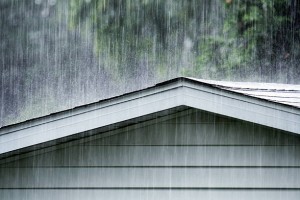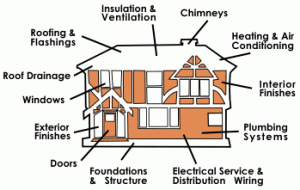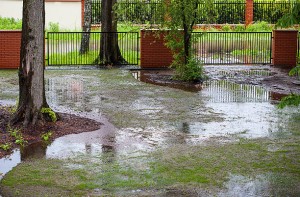Home Inspections Can Help Current Home Owners Save Money
March 14, 2024 | Posted in Uncategorized | By Mike Doetsch
How long has it been since you had a professional home inspection for your home? If the answer is years, or never, a professional home inspection should be at the top of your to-do list.
A home inspection is essential for anyone buying a home, but current home owners will benefit from having one as well.
Chances are you have lived in your home long enough for changes to take place to all of its components. A home inspection can help you find and address a problem before it leads to damage or costly repairs.
Would you like an unbiased opinion about the condition of your roof, siding, furnace, air-conditioning, chimney, etc? A home inspector will evaluate the elements of your home from a purely objective point of view. He or she draws no benefit from finding defects – or the lack thereof – and therefore is a more reliable source of information than someone who is paid to do repair work. Not only that, a home inspector evaluates all of a home’s components, all in one visit. Think of it as a physical check-up for your home.
For example, do you know how well your roof or siding are holding up to snow and extreme temperatures? Are there any signs of leaks, mold, or structural damage throughout your home? Have any contractors done work in your home since you bought it, and was that work performed correctly? Is your furnace operating inefficiently or, worse, leaking dangerous carbon monoxide into the air? Could replacing an aging water heater be all that is needed to prevent thousands of dollars in costly water damage?
These are only some of the issues that overwhelm home owners. Having a home inspection can help you properly maintain your home, as well as identify potential problem areas before they deteriorate and become costly.
REMEMBER: If we perform a home inspection for you our expertise is available to you for as long as you own your home. We will happily answer any questions you may have.
Spring Cleaning – Get Ready for Rain
March 9, 2024 | Posted in Uncategorized | By Mike Doetsch
Comments Off on Spring Cleaning – Get Ready for Rain
It’s a beautiful day here in Chicago! A great chance to open up some windows and begin a little Spring cleaning. Removing dirt and debris from window tracks and away from weep holes will ensure that your windows drain well when heavy rains come. An old toothbrush works well for getting dirt out of the tight corners. It’s also a good chance to finally let a little fresh air into the house to clear out indoor air pollution that may have built up in the stagnant winter air. Enjoy the sunshine and mild weather this week!
Avoid Flood Damage with a Few Simple Home Repairs
February 28, 2024 | Posted in Uncategorized | By Mike Doetsch
Spring has arrived in the Chicago area, and while it is a welcome sight, it brings with it wildly fluctuating weather conditions. As rains soak the city and surrounding suburbs, homeowners everywhere may find themselves battling flooding situations. Even if your home is situated a safe distance from a body of water, you can still suffer the effects of torrential rains, as saturated or still-frozen soil allows the water to seep around foundations, into basements and crawlspaces. Therefore, we are touching on many water-related home maintenance issues. Water damage happens so easily, is very exhausting to clean, and can be terribly costly to repair, so we want to keep you well informed about protecting your home.

In addition to maintaining gutter systems, as described in a previous article, maintaining an appropriate grade around your home is equally important. Properly functioning gutters work in conjunction with proper grading around a house. The gutter’s purpose is to effectively divert water away from the foundation, but many homes will have developed a negative grade around the foundation due to settling of the soil. If water is draining from a roof into an area of negative grade, it will pool around the home’s foundation and quickly enter any cracks or windows in that area, draining into the adjacent area of the home. If you notice settling around your home, don’t be alarmed; it is a very normal occurrence and can easily be remedied.
Settling occurs as back-filled soil sinks around the new foundation, and usually happens within five to seven years after a home is built. Over time, the displaced soil settles into the air pockets around the homes foundation, causing a negative slope toward the home instead of away from it. Correcting the problem is easy, as you simply need to have additional soil added to areas of negative grade around the foundation. It is a simple solution, but not a labor-free one, so while you could certainly apply soil to the needed areas yourself, you might want to enlist the services of a local landscaper or nursery to do the job for you.
Whether you choose to complete the work yourself or hire someone, make sure that the process follows these guidelines:
- Landscaping may obscure a settling problem and may need to be removed in order to properly back-fill and correct the grading.
- The settled area should be back-filled with a heavy clay-based soil — not mulch, stone, sand, etc.
- The grade around a foundation should start six to eight inches below the siding and/or below the sill plate on the foundation.
- Grade the new material so that it is pitched at one or two inches per linear foot away from the house.
- Sometimes a high soil level can make it difficult to achieve this grade, and in these cases a swale may be added between seven to ten feet away from the house to divert water away from the foundation. French drains may also be installed to help divert water away from the house.
Hopefully this information will help you keep your home water-tight this season. If you have any questions, don’t hesitate to ask. And don’t forget, Home Inspections aren’t just for buyers or sellers – It’s always a good idea to have the condition of your home evaluated by an unbiased professional. If you would like a thorough evaluation of your current home’s maintenance needs, just contact us to schedule a Maintenance Check-Up Inspection!
When it Comes to Finding the Right Inspector, Experience is Key
February 1, 2024 | Posted in Uncategorized | By Mike Doetsch
Comments Off on When it Comes to Finding the Right Inspector, Experience is Key
Have you recently decided to purchase a home? Are you looking for a great inspector to make sure your investment is a worthwhile endeavor? It’s likely you’ve been told by your realtor, friends, or family to make sure you have a home inspection performed. And certainly we at INSPECT, INC. would tell you that you need look no further, you can rest assured that we are a sound choice. But how do you, the consumer, ultimately choose a home inspector that you trust is reliable, and what attributes make a great one?
You don’t want to follow someone’s recommendation or hire a mutual friend only to find that he or she missed an important defect in your home. While there are many important qualities in an inspector, such as professional affiliations and continuing education, the number one factor guiding your inspector search should be experience level – specifically the number of years that the inspector has been an active home inspector and the number of inspections he or she has personally performed. The number of inspections should reach well into the thousands, preferably around 5,000 or more, and with that many inspections in their history, it is likely an experienced inspector will have been actively inspecting for a decade or longer. Sufficient experience is the one characteristic of your home inspector that you must insist on, otherwise there is no point paying for a professional inspection!
The single most effective way for an inspector to develop their essential skills is through experience in the field. Classroom exercises can only teach the basic flow of a home inspection and usually involve following a simple check-list through a home. While this education is essential to building a good foundation, it is the many yea rs of hands-on experience which teaches an inspector where problem spots occur and how to quickly identify them. Certain building styles have common defects, and homes built in different eras have unique building materials that are prone to specific problems. Having a truly qualified inspector can mean the difference between a dream-come-true and disaster: The discovery (or lack thereof) of defects, unbiased disclosure, and a clear understanding of all the home’s components are all essential to making a sound investment.
rs of hands-on experience which teaches an inspector where problem spots occur and how to quickly identify them. Certain building styles have common defects, and homes built in different eras have unique building materials that are prone to specific problems. Having a truly qualified inspector can mean the difference between a dream-come-true and disaster: The discovery (or lack thereof) of defects, unbiased disclosure, and a clear understanding of all the home’s components are all essential to making a sound investment.
Buying a home is likely the single biggest investment you will make in your lifetime. Making sure it is safe for you and your family is the most important reason for having a home inspection. Michael Doetsch, owner of INSPECT, INC has personally performed more than 11,000 inspections over the past 25 years. You can rest assured that INSPECT, INC. is a team of home inspectors with extensive experience who are at the top of their field, and we will provide you with the information you need to make an educated decision about your investment.
Do you need a Home Inspection for a newly constructed home?
January 20, 2024 | Posted in Uncategorized | By Mike Doetsch
Comments Off on Do you need a Home Inspection for a newly constructed home?
 Why a home inspection is essential for new construction
Why a home inspection is essential for new construction
If you’re building a new home, a home inspection might not be on the top of your to-do list. But if you forego this inspection it could cost you thousands of dollars in the long run. Here, we explain why a home inspection is one of the most important elements of new construction.
Why should I have a home inspection performed on a newly constructed home when the house is built to code and inspected and approved by the building department?
- Building codes themselves are the bare minimum required to make a home safe for occupancy.
- Municipal inspections usually only last 20-30 minutes, which is evidence that they are nowhere near as thorough as a private home inspection by Inspect, Inc. When you hire Inspect, you can expect us to perform an exhaustive inspection of your home and be on site for 2 hours or more depending on the size of the property being inspected.
- A municipal inspection looks at the completed project, but does not test the operation of the built-in fixtures and appliances attached to the utilities.
- The utilities are not turned on until all have been signed off by the municipal inspector. Therefore, these components – such as gas, water, and electricity – are not actually inspected for proper function by the building department. The best time to check the operation of these functional components is during a home inspection, after the utilities have been activated.
- The best time to inspect a newly constructed home is when it is brand new, while the builder’s warranty is still in effect.
Some of the items that Inspect, Inc. will examine, which are often bypassed in new-construction inspections:
- Examine the operational flow of water, and check for proper installation of plumbing fixtures and faucets. We look for loose or leaking connections. Faucets are turned on and drains are tested for leaks. These items are not covered by a municipal inspection.
- Inspect for gas leaks at piping and appliances.
- Check for the correct polarity, proper grounding, and operation of GFCI and AFCI faults in the electrical system.
- Inspect the function of all built-in appliances, including garbage disposals, dishwashers, ovens, ranges, cook tops, ceiling fans, exhaust fans, and garage door openers – all of which are not examined by municipal inspectors.
- Enter attics and crawl spaces, checking for proper ventilation and insulation value.
- Walk on roof to check for the proper installation of shingles, flashings, vents, etc. Check for any damaged or missing roofing components, weather permitting.
- Check for proper operation and installation of the heating and cooling systems, operation of the water heater(s), and evaluation of fireplace(s).
 We understand that all new homes have some defects, usually minor, but potentially costly. Having us perform a home inspection on your new home gives you the best opportunity to take advantage of the builder’s warranty as well as learn what to expect in the future as the home settles into its new foundation. By not having a professional home inspection you may be putting yourself at risk for underlying problems that surface in the future.
We understand that all new homes have some defects, usually minor, but potentially costly. Having us perform a home inspection on your new home gives you the best opportunity to take advantage of the builder’s warranty as well as learn what to expect in the future as the home settles into its new foundation. By not having a professional home inspection you may be putting yourself at risk for underlying problems that surface in the future.





